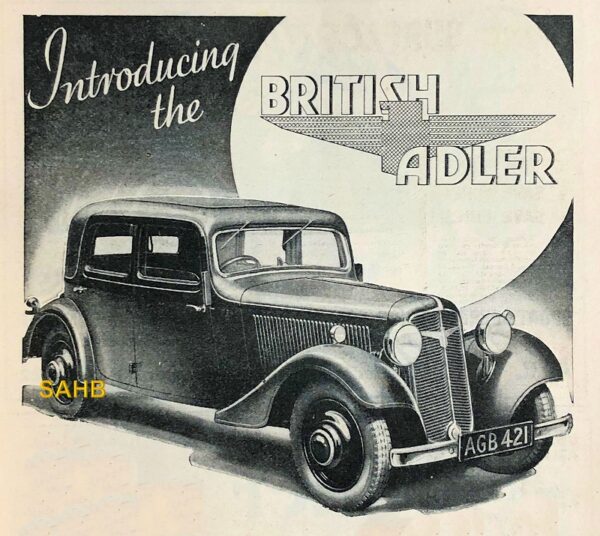
In 1930 only 1,880 cars were imported into Britain from the three main manufacturing companies in mainland Europe, namely Germany, France and Italy – 1.2 percent of registrations. In 1938 that figure had risen to 5,660, or 2 percent of registrations, with Germany in the lead. It is therefore unsurprising to find German cars being advertised in British car magazines.
There were at this time some accusations of dumping at low prices, so the prominent use in this 1935 advertisement for an Adler car of the words “British Adler” is perhaps understandable. There was, however, no manufacturing facility in Britain for the Adler; this was merely an attempt to give a British feel to a car built in Germany.
The Adler company was founded in 1900 and made bicycles, typewriters, motorcycles and calculators in addition to cars. Before World War I, it used De Dion two- and four-cylinder engines and from 1902 built its own engines as well.
The car in our Snapshot is the Adler Trumpf, designed by Hans Gustav Röhr and introduced in 1932. It was advanced for its day, with front-wheel drive, independent suspension all round and hydraulic shock absorbers that could be adjusted from the dashboard of the car. Its sister model, the Primus, was launched in the same year with conventional rear-wheel drive and the Trumpf used the same engine and gearbox but turned through 180 degrees. This placed the gearbox in front of the engine but behind the front axle, which made for a particularly long bonnet that gave the car a sleek and dynamic look. The first Trumpfs were powered by four-cylinder 1.5-litre engines, but in 1933 a 1.7-litre was available with an increase in horsepower to 38bhp. Trumpfs were also built outside the main Adler factory in Frankfurt – by Imperia in Belgium and Rosengart in France.
The British advertisement succinctly referred to the ‘Adler rattleproof “unit” bodywork’; these all-steel bodies were provided by Ambi-Budd of Berlin. There were two- and four-door “Limousines” (saloons) and a cabriolet, and the 1-litre Adler Trumpf Junior was also available to British buyers. The Trumpf 1.7 was replaced directly in May 1936 with the Adler Trumpf 1.7 EV, more streamlined than before.
After World War II, a decision was made not to resume car construction. Motorcycle production resumed in 1949 and continued for 8 years. As part of Allied war reparations, Adler motorcycle designs were taken by BSA in Britain and later used by the British company Ariel to produce their ‘Arrow’ and ‘Leader’ models. Increasingly, Adler focused on the manufacture of office equipment; it was taken over by Grundig in 1957, then later by Olivetti.
Image courtesy of The Richard Roberts Archive: www.richardrobertsarchive.org.uk







Leave a Comment